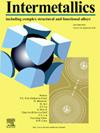以Ti箔为中间层的Ti2AlNb扩散焊接头的组织与力学性能
IF 4.8
2区 材料科学
Q2 CHEMISTRY, PHYSICAL
引用次数: 0
摘要
以纯Ti为中间层,在940 ~ 980℃的温度下,在80 MPa的压力下对Ti2AlNb合金进行扩散键合。在所有的键合温度下都实现了完整的冶金键合。结果表明,焊缝区(WZ)始终由α相和β相组成。较高的键合温度显著增强了元素的扩散,导致WZ的形成更厚、更均匀。随着键合温度的升高,WZ的显微硬度升高,而基体的显微硬度略有下降。随着结合温度的升高,接头的拉伸性能先提高后恶化。同时,接头的断裂方式由准解理断裂向韧性断裂过渡,最终演变为解理断裂和韧性断裂的混合模式。在960℃时粘结的接头强度塑性平衡最佳,抗拉强度为979 MPa,延伸率为18.9%。结果表明,在940℃时,由于WZ中α2相的过量,以及基体相中不同滑移体系的激活,导致接头过早断裂。在980℃下焊接的接头,温度过高导致基体组织恶化。基体中所有初生O相的溶解降低了基体的强度,在拉伸测试中导致基体内部断裂,与960℃时结合的接头相比,拉伸性能下降。本文章由计算机程序翻译,如有差异,请以英文原文为准。
Microstructure and mechanical properties of Ti2AlNb joints diffusion bonded using Ti foils as interlayer
Ti2AlNb alloy was diffusion bonded using pure Ti as an interlayer at temperatures ranging from 940 °C to 980 °C under a pressure of 80 MPa. A complete metallurgical bond was achieved at all bonding temperatures. It was found that the weld zone (WZ) consistently consisted of α and β phases. A higher bonding temperature promotes significantly enhances elemental diffusion, leading to the formation of a thicker and more uniform WZ. As the bonding temperature increased, the microhardness of the WZ rose, while that of the matrix slightly decreased. With the increasing of bonding temperature, the tensile performance of the joints initially improved and then deteriorated. Meanwhile, the fracture mode of the joints transitioned from quasi-cleavage fracture to ductile fracture, and ultimately to a mixed mode of cleavage fracture and ductile fracture. The joint bonded at 960 °C exhibited the optimal strength-plasticity balance, with an ultimate tensile strength of 979 MPa and an elongation of 18.9 %. It was observed that the premature fracture of the joint bonded at 940 °C was due to an excess of α2 phase in the WZ, along with the activation of different slip systems in the matrix phase. For the joint bonded at 980 °C, the excessively high temperature deteriorated the matrix microstructure. The dissolution of all primary O phase in the matrix reduced its strength, resulting in fracture within the matrix during tensile testing, which led to a decrease in tensile properties compared to the joint bonded at 960 °C.
求助全文
通过发布文献求助,成功后即可免费获取论文全文。
去求助
来源期刊

Intermetallics
工程技术-材料科学:综合
CiteScore
7.80
自引率
9.10%
发文量
291
审稿时长
37 days
期刊介绍:
This journal is a platform for publishing innovative research and overviews for advancing our understanding of the structure, property, and functionality of complex metallic alloys, including intermetallics, metallic glasses, and high entropy alloys.
The journal reports the science and engineering of metallic materials in the following aspects:
Theories and experiments which address the relationship between property and structure in all length scales.
Physical modeling and numerical simulations which provide a comprehensive understanding of experimental observations.
Stimulated methodologies to characterize the structure and chemistry of materials that correlate the properties.
Technological applications resulting from the understanding of property-structure relationship in materials.
Novel and cutting-edge results warranting rapid communication.
The journal also publishes special issues on selected topics and overviews by invitation only.
 求助内容:
求助内容: 应助结果提醒方式:
应助结果提醒方式:


